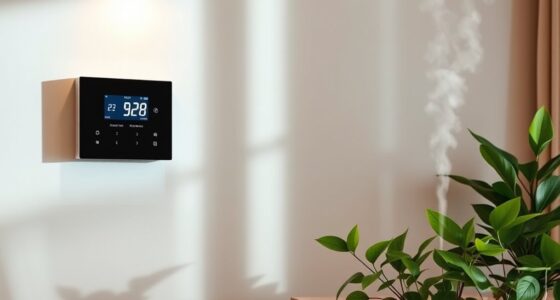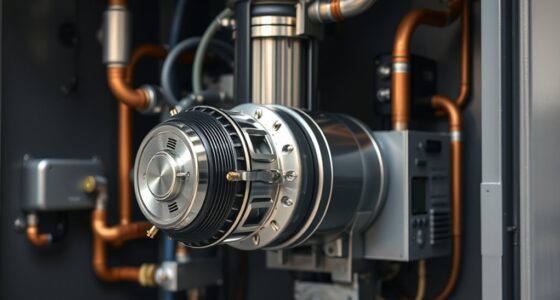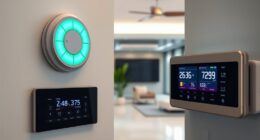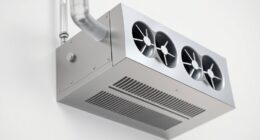By integrating voice assistants into your climate control system, you can easily customize commands to fit your preferences and automate routines for maximum comfort and energy efficiency. You can tell your device to set specific temperatures, humidity levels, or switch between modes with natural language. The system learns your habits over time, optimizing settings automatically. To discover how to make your smart home even smarter, explore the details below.
Key Takeaways
- Integrate HVAC and environmental devices for seamless voice-controlled climate management.
- Personalize commands and routines for effortless temperature, humidity, and airflow adjustments.
- Utilize advanced voice commands to specify detailed climate preferences like fan speed and humidity levels.
- Leverage learning features that adapt to user habits for automatic, optimized comfort settings.
- Enable proactive adjustments based on weather, occupancy, and time to maximize energy efficiency.

Climate control voice assistants are transforming how you manage your home’s heating and cooling systems. With these devices, you can effortlessly adjust your thermostat, set schedules, and monitor your environment without ever leaving your couch or walking to the thermostat. As you incorporate voice assistants into your smart home, you’ll find that seamless smart home integration makes controlling multiple devices straightforward. Instead of juggling separate apps or manual switches, you can unify your HVAC, lighting, security, and other smart systems into a single voice-controlled ecosystem. This level of integration not only simplifies your daily routines but also enhances energy efficiency, saving you money over time.
One of the key advantages of using voice assistants for climate control is voice command customization. You can personalize commands to suit your preferences, making interactions intuitive and natural. For example, you might say, “Set the living room temperature to 72 degrees,” or “Make it cooler in here,” and your voice assistant will interpret and execute these requests accurately. Many systems also allow you to create routines or presets, such as a morning warm-up or evening cool-down, which can be activated with a simple phrase. Custom commands ensure that managing your environment feels effortless and tailored to your lifestyle, reducing the need for manual adjustments.
Personalize your climate control with simple, natural voice commands and routines for effortless home comfort.
Furthermore, voice command customization extends beyond simple temperature changes. You can specify humidity levels, fan speeds, or even combine commands to optimize comfort and efficiency. For instance, you could say, “When I say good morning, turn on the bedroom heater and start the dehumidifier,” and the system will handle it all automatically. This kind of flexibility empowers you to create a personalized climate experience, ensuring your home is always comfortable with minimal effort. Additionally, learning user preferences can help your system automatically adjust settings over time for maximum comfort. Over time, as you familiarize yourself with the capabilities and customize your commands, you’ll notice how intuitive and responsive your smart climate control system becomes.
In addition to convenience, these integrations and customizations also enable proactive energy management. Your voice assistant can learn your preferences and suggest optimal settings based on time of day, weather forecasts, or occupancy patterns. This proactive approach helps you maintain a comfortable environment while minimizing energy waste. With smart home integration, you can even set your system to automatically adjust when you’re away or asleep, further enhancing efficiency. The ability to customize your voice commands means you’re always in control, shaping your home’s climate to fit your exact needs without complex configurations or manual programming. Overall, these features make managing your home’s temperature more intuitive, efficient, and tailored to your lifestyle.
Frequently Asked Questions
Can Voice Assistants Learn My Preferred Climate Settings Over Time?
Yes, voice assistants can learn your preferred climate settings over time through advanced learning algorithms. They analyze your commands and adjust for better personalization accuracy, making future adjustments more aligned with your comfort. As you repeatedly set your ideal temperature or humidity, the assistant refines its understanding, ensuring it responds faster and more accurately. This ongoing learning process helps you enjoy a more tailored climate control experience effortlessly.
How Secure Is My Data When Controlling Climate Systems via Voice?
Your data security when controlling climate systems with voice assistants depends on the company’s practices. They often use data encryption to protect your information during transmission and storage. Additionally, many devices prioritize user anonymity, minimizing data shared with third parties. However, it is crucial to review privacy policies and settings to guarantee your personal data remains secure. Being cautious helps you enjoy voice-controlled climate management without compromising your privacy.
Are There Compatibility Issues With Different HVAC Brands?
About 60% of smart home users face compatibility issues with their HVAC brands. You might find that brand compatibility varies, and not all devices integrate seamlessly. Before purchasing, check if your HVAC system supports device integration with your voice assistant. Some brands have open platforms, making integration easier, but others may require additional hubs or adapters. Ensuring compatibility upfront helps you avoid frustration and enjoy smooth climate control.
Can Voice Assistants Detect and Respond to Indoor Air Quality Changes?
Yes, voice assistants can detect and respond to indoor air quality changes when paired with air quality sensors. These sensors monitor pollutants and humidity levels, sending data to your voice assistant. You can then use voice commands for adjustments, improving air quality. However, the accuracy of responses depends on voice command accuracy and sensor quality. Make sure your devices are compatible and properly calibrated for the best results.
What Are the Privacy Implications of Using Voice-Controlled Climate Devices?
Using voice-controlled climate devices is like handing over your diary; it raises privacy concerns. You might worry about data encryption and maintaining user anonymity, as these devices constantly listen and transmit information. While manufacturers aim to protect your data, there’s always a risk of breaches. Be cautious, review privacy policies, and set device controls to limit data sharing, so you keep your environment safe and your secrets secure.
Conclusion
By harnessing voice assistants for climate control, you gain effortless comfort at your command. Yet, as seamless as it feels, remember that behind the scenes, complex systems work tirelessly to adjust your environment. It’s a quiet reminder that while technology simplifies your life, it also relies on intricate networks you rarely see. Embrace the convenience, but stay curious about the smart systems shaping your comfort—because the future of climate control is as fascinating as it is functional.









